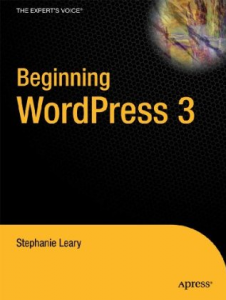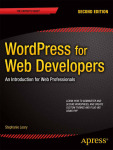 Beginning WordPress 3 is outdated! You should get the new edition instead: WordPress for Web Developers. (It’s the same book, only updated; we changed the title to make its intended audience clearer.)
Beginning WordPress 3 is outdated! You should get the new edition instead: WordPress for Web Developers. (It’s the same book, only updated; we changed the title to make its intended audience clearer.)
Unless you’re creating a simple blog, the key to creating a robust WordPress site is choosing the right combination of plugins to accomplish your goals. Here are a few recipes for turning a WordPress installation into something more.
Wiki
The combination of Sidebar Login, Front End Editor, and Posthaste will allow users to register, edit, and create new posts without ever seeing the WordPress administation screens. In order to let new users publish posts and edit posts written by others, you’ll need to either choose Editor as the default role for newly registered users, or choose Author or Contributor and use the Members plugin to adjust the role’s editing capabilities. Revision History appends a list of the post revisions to the_content() in your theme. My Favorite Posts adds a watch list feature, and Hackadelic SEO Table Of Contents generates the familiar wiki-style table of contents based on the post or page headings. For easier internal linking, try Simple Internal Links or RB Internal Links.
The built-in comments feature can serve as the Talk function. With a little help from the jQuery Tabs library (built in), you can show the content, history, and comments in separate areas.
Document sharing
For a committee or a club, finding a good way to share news and documents is always tricky. The Members Only plugin is ideal if your content should be visible only to registered users. Again, Sidebar Login is useful for letting people log in without dealing with the somewhat intimidating Dashboard. The List Child Attachments plugin (http://code.google.com/p/list-child-attachments/) will list any files uploaded to a post or page, without the user having to insert each one into the content individually – that is, it works like a gallery, but for files other than images.
The Event Calendar or GigPress will be useful if your group needs to keep track of events. To let the group stay in touch by email, Subscribe 2 and Subscribe to Comments will notify all users of new posts and new comments.
If your group needs to review documents, the Comment Author Checklist plugin prints a list of registered users, and crosses people’s names off the list once they’ve commented on a post. The Digress.it plugin (http://digress.it/) allows paragraph-level commenting, suitable for academic-style peer review.
Project management
The CollabPress plugin builds basic project management – task assignments and due dates – into the dashboard screens. The plugin includes email notifications for newly assigned tasks, and it places a widget on the Dashboard displaying recent activity.
Newsroom
In addition to the Editorial Calendar and Edit Flow plugins described in Chapter 10, your newsroom will probably want to keep a close eye on your visitor statistics. In addition to Google Analyticator and the WordPress.com Stats plugins, use Google’s free Feedburner service with the FeedSmith plugin to closely track your RSS readers. The service also provides an email digest of your RSS feed, which might help if you need to reach people who aren’t familiar with RSS.
Twitter archive
As described by Doug Bowman (http://stopdesign.com/archive/2010/03/02/browsable-searchable-archive-of-tweets.html), it’s possible to use WordPress to create a long-term archive of your Twitter account. The TwitterTools plugin has an option to create a new post from each of your tweets. If you’re new to Twitter, just set up the plugin and let it run. If you have an existing Twitter account with a long history, you’ll need to import your old tweets into WordPress somehow. Bowman recommends the service from http://tweetbackup.com. Another service, TweetScan, lets you export a CSV file, which you could then import using the CSV Import plugin.
News clipping archive
Much like the Twitter archive, a news clipping archive in WordPress provides you with a searchable database of content that would otherwise be walled off in third-party sites. First, you’ll have to create some news alert feeds using services like Google Alerts or Google Blog Search. You can then create the archive automatically from those feeds using FeedWordPress. However, if you find that the feeds return lots of false positives, you might want to curate your archive by hand instead. The PressThis bookmarklet (http://en.blog.wordpress.com/2008/08/14/press-this-bookmarklet/) makes it easy to create new posts from stories you see on the web.
For better search results, be sure to include a brief excerpt of each article in addition to the title. Don’t copy the entire thing, though, if the article is under copyright (which it almost certainly is).
If you’re creating the archive for your business or organization, include the calendar widget in your sidebar. You’ll probably have a few avid users who keep up with the archive daily. They’ll appreciate being able to easily navigate the recent history when they miss a few days due to a trip or an illness.


